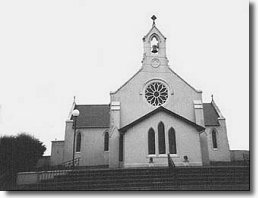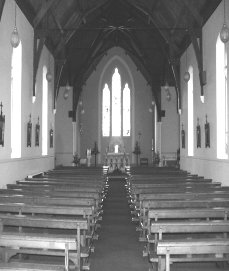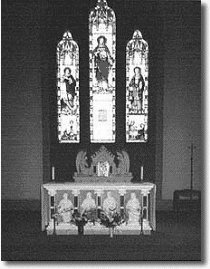|
ST.MARY'S CHURCH KILFLYNN John Flaherty
Historically, Abbeydorney and Kilflynn were different parishes, Kilflynn had the church of the people of Flann, a saint who lived the life of a hermit monk locally, about the 7th century, while Abbeydorney had the church of the people of Torna. In the early years of the twelfth century Ireland was divided into dioceses, these in turn were broken up into parishes. When the Cistercians founded their monastery in Abbeydorney they looked after that parish while Kilflynn had a parish priest. The earliest church building in Kilflynn is thought to have been situated in the middle of the present village, somewhere between the present pubs and the old graveyard. Stones in an arranged fashion were found on this site during the sixties. Some people say it was the site of a castle that of Fitzmaurice in the twelfth century, but this castle was built higher above the village with a strategic view of Tralee Bay and right around to the mouth of the Shannon. During the sixteenth century the demise of the catholics began when Henry V111 of England declared himself head of the church here in Ireland also. Monasteries were closed and the English Monarchs took over the churches enlisting their own ministers. The catholics refused to attend these churches, thus they fell into disrepair and many were lost forever. It was during these times and the penal days which followed the Treaty of Limerick of 1691 that Kilflynn lost her church. There was no Catholic Church and no church records were kept. Stations were held in the homes which were organised into groups and priests went in turn to the individual homes within the group system twice a year. This is where the station tradition began and in seclusion the priests nourished their flock spiritually through the dark years. When a certain degree of tolerance was given to the catholics they were again allowed build a church in Kilflynn. This "bothan" church was mud walled and thatched and there were no seats for the congregation. This "bothan" church was built on the plot of ground directly to the west of the curate's present house at the east side of the village. This spot was marked by an Iron Gate surmounted by a cross, which was only removed in the early seventies when the sewage system was run through the village. This important piece of history is now probably rotting in someones backyard. This old church is clearly marked on the old ordnance survey maps. This thatched church survived until Catholic Emancipation of 1829 won greater freedom for Catholics and by 1847 after gradual improvements a stone church was able to be built. The 1847 church was of a simple rectangular shape, the remains of which are the two side aisles of the present church. A protestant landlord, Mr Samuel Julian gave the site at a rental of one shilling a year. Mr Julian was a most kind man and wanted to give the site for nothing but the catholics insisted on paying the shilling rent in case of trouble with a future landlord. The freehold was bought out by the dioceses of Kerry during the land Acts of 1890s for £20 which covered arrears of rent and legal costs of conveyance. The 1847 church was orientated east-west as all churches were at that time. The altar was at the west side and the door at the east. Signs of the old altar and flags of the old porch were found during the 1978-79 refurbishment. The church was built of rubble stone and mortar, unlike the churches in Kilmoyley, Lixnaw and Ardfert which were later, as catholics became richer, built of cut stone. The church was consecrated in 1848 and at that time Fr. Thomas Fitzgerald was the parish priest of the combined parishes of Abbeydorney and Kilflynn. By the 1930s the 1847-48 church had become too small for the needs of the area, so it was in 1930-32 that the church took on its basic present shape. In this reconstruction the stone church became the transept of the present Catholic church. To have left the church in its rectangular shape would have meant knocking all of the southern wall. The site was there to extend the church in a north-south direction as the old national school which once stood to the south of the 1847 stone church had burned down in 1908. The cement blocks for the 1932 church were cast on the site and the work was done by the well known North Kerry tradesmen, The Falvey brothers, Mick, John, Mortimer, Tom and William. Local man John Herbert who worked on the construction is still as lively as ever and was very helpful with this article. Although it is thought that no contract was signed for the job, it cost about £2,000 at the time. The material was bought at Murphy's builders providers in Tralee, who operated across the road from the Dominican church where the Social Welfare Offices now stand. The late Richard Condon of Kilflynn organised the money and held the purse and all households subscribed to the project according to valuation. A feature of the church was the pine ceiling which still forms a major attraction today. The pine seats which are still in immaculate condition were manufactured by a Mr Tom Moriarty at Murphys in Tralee. John Herbert tells me he started work on the roof of the week of the Eucharistic Congress in June 1932. An altar was bought for a bargain price in 1932 from a church in Kanturk, whose design it did not suit. This information was given to Fr. Nolan by the late Richard Condon. This altar was an elaborate structure and the reredos of this altar, featuring the four Evangelists, is now the present altar in Kilflynn. The Angels which now stand on each side of the tabernacle were the outer wings of this altar. Altar rails were also constructed at the time. During the reconstruction, Mass was said in the school. Fr. McDonnell was the P.P. at the time and a Fr. O'Shea was the curate. Between 1932 and the late '70s little was done to the church apart from the usual maintenance. During the 1950s the outer walls were pebble dashed and taraso - that is hard polish stone, floors were laid. Fr. Nolan, our present P.P., was the first curate of the combined Abbeydorney/Kilflynn parish to come to live in Kilflynn, although not the first priest it seems. The aforementioned Fr. Thomas Fitzgerald (1847 period) who was parish priest of the combined parishes had property in Kilflynn and lived there for some time, the Griffith survey says this. When Fr. Nolan, first arrived in 1976 a boundary wall collapsed during his first winter and the church itself was in very bad repair. A public meeting was called to deal with the situation and it was proposed, from the floor, that work needed to be done immediately. A decision was taken to start an envelope collection and renovation was done at a cost of £30,000. By learning from the mistakes of other churches renovated, St. Mary's church, Kilflynn managed to retain most of its old attraction and charm. Many items with which the people had a long devoted association were retained.. The old 1932 altar was taken completely to pieces and the present altar built with much of that material, as mentioned above. The old pine roof and seats were retained together with many of the statues. The boundary ditch/wall and gates by the road were taken away and an access point was made into the church at the western side. The altar rails were removed and a carpet tile floor covering was laid throughout. A porch was also constructed and to the right of this porch the original 1848 date stone was embedded in the wall. The work began in June 1978. Matty Quinn of Asdee was the contractor and John King, then the Diocesan clerk of works was there to oversee the work. On Sunday, Octobr 5th, 1979, the then Bishop of Kerry, the late Bishop Kevin McNamara blessed and re-dedicated the church. At a reception for the parishioners afterwards, the Bishop complimented the people on the standard of work which had been carried out. In the early '80s to mark the year of the handicapped a wheelchair entrance was added at the eastern side of the church and extra car-parking space was made as a result. This entrance is now also used for taking the remains both in and out of the church at funeral times, previously coffins had to be lifted up the steps at the front of the church. There is seating accommodation for 350 people in the present church. The 150 or so families of the area are very proud of their special church. St. Mary's, Kilflynn, is one of the most beautiful churches in Kerry and people come here from all over to Mass. The church itself is overflowing with history, built during the famine, rebuilt at the time of the Eucharistic Congress and re-dedicated the year the Pope came to Ireland. The church has a special charm and attraction and long may it stand as a monument to all those connected with it in the past.
|


